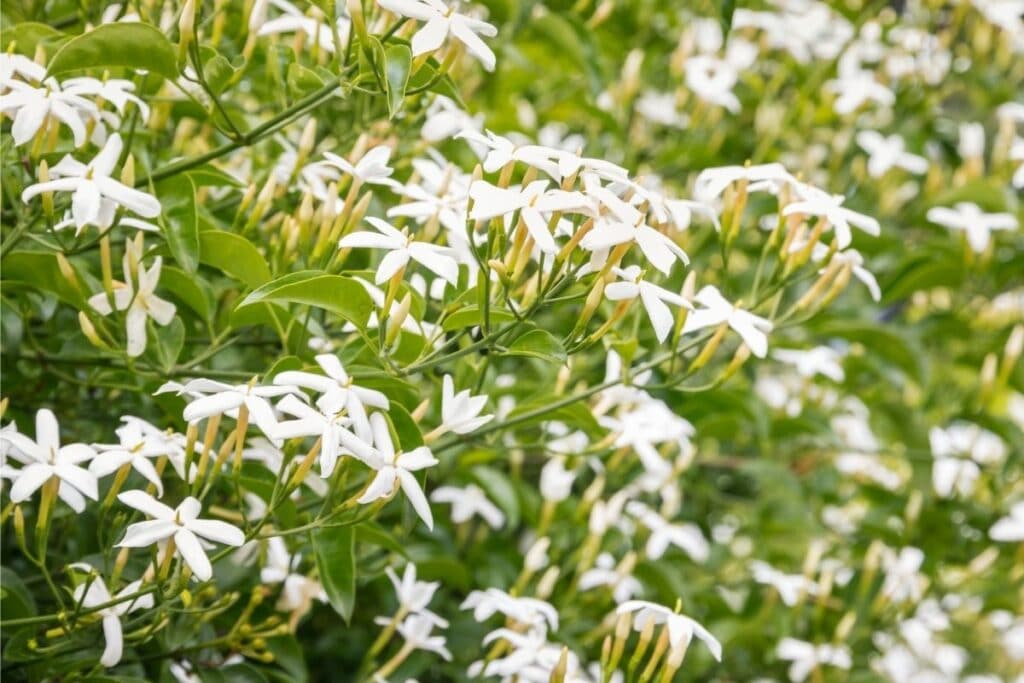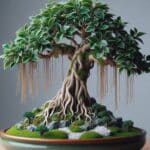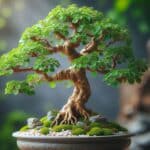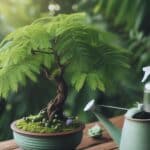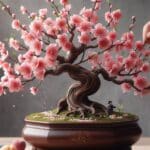Though technically related to the milkweed plant, jasmine, also known as star jasmine or confederate jasmine, is the perfect plant for bonsai. Native to Asia, including places like Korea, Vietnam, China, and Japan, this plant has a delicate flowering habit and shiny dark leaves.
The plant is often grown for its valuable oil, which can be extracted and used for perfume. As you might expect, this plant has a heavenly fragrance that makes it the perfect plant for indoor or outdoor growing alike.
Of course, its roots are also interesting to look at and to train. Because of this, it’s a plant you’ll want to add to your bonsai collection as soon as possible – and growing jasmine bonsai is likely easier than you think.
What is Jasmine Bonsai?
Jasmine Bonsai is a type of bonsai tree cultivated from the Water Jasmine or Wrightia Religiosa species, a tropical plant native to eastern and southeastern Asia. It is an evergreen woody vine that can be trained to grow in a tree form, making it an ideal choice for bonsai enthusiasts.
The White Jasmine blooms of this flowering plant are one of its most attractive features, emitting an intense fragrance that is sure to please the senses.
Most of the White Jasmine varieties, including Trachelospermum Jasminoides, can also be grown as a bonsai tree. Its flowers have five petal-like lobes and a tube-like corolla opening, creating a beautiful contrast to the delicate white flowers of the Water Jasmine Bonsai.
Interesting Facts about Jasmine Bonsai
| Height | 12-16” |
| Width | 4-6” |
| Sunlight | Full sunlight |
| Flowering Time Length | Continuously when grown indoors |
| Lifespan | 100+ years |
| Scientific Name | Trachelospermum jasminoides, member of the milkweed family |
| Native To | Eastern and Southeastern Asia (including southern China) |
Growing Jasmine Bonsai from Seed or by Propagation
Jasmine bonsai can be grown from seed but it’s best to start your plant by purchasing one that has already been trained to a bonsai container. This will ensure your plant can handle the unique conditions of bonsai growing.
How to Care for Jasmine Bonsai
Jasmine bonsai trees are actually a type of water jasmine (wrightia religiosa), a tree species native to tropical regions in eastern and southeastern Asia, including southern China. While in their natural form, water jasmine trees grow into a tree form, their bonsai counterparts are carefully pruned and trained to maintain their small size and intricate form.
Proper care is essential for maintaining a healthy and thriving jasmine bonsai tree.
Here’s how to do it.
Sunlight
Jasmine bonsai performs best when grown in high light conditions. Jasmine bonsai trees prefer full sun exposure and high humidity levels, so if you live in an area with less than warm climates, consider using grow lights or placing a small humidifier near your tree.
If you grow it outdoors (something that is possible in most climates in the late spring and summer), just be sure to bring it indoors when temperatures drop below 45 degrees. Inside, your bonsai jasmine will thrive in front of a sunny window.
During the winter, it’s best to place your plant on a window that has southern exposure. Four to six hours of sunlight per day is ideal.
How to Water Jasmine Bonsai
Jasmine plants do not like to be dried out. Water jasmine bonsai before the soil looks dry and never let it get completely dry. Until you get used to watering your bonsai, you may need to use a moisture meter to get used to how much water jasmine bonsai requires.
Water the jasmine bonsai liberally, until water starts to run out of the holes in the bottom of the container. That said, regular watering is imperative, but be careful not to overwater. Too much water can lead to yellowing leaves and root rot, which can be fatal to your tree.
Humidity is also essential for this plant. You may want to place your plant on a shallow tray filled with gravel and water, which will provide moisture to the tree (without saturating its roots) as the water evaporates.
Fertilizing
Fertilize your jasmine bonsai plant regularly. Feeding your jasmine bonsai with a liquid fertilizer during its growing season can help promote strong growth and healthy foliage.
A general-purpose liquid fertilizer is perfect. For this particular tree species, a recommended strength is one-quarter of the manufacturer’s suggested dose.
Fertilize once a month when the plant is actively growing during the spring, summer, and fall months, but hold off on fertilizing during the dormant winter period. You may also choose to apply a foliar feeding to your plant, ideally by using a water-soluble fertilizer that you can apply every other month.
Potting and Repotting
You will need to repot your bonsai whenever the root system fills the pot in which it is currently growing. If you can see the roots poking out from the bottom of the pot, it’s time to consider repotting. Usually, this will mean about once every two to four years, although sometimes jasmine plants can go up to five.
Repot the plant in the midsummer, when the tree is least fragile. Remove the plant from the pot, including all of its soil. Trim about a third of the plant’s root mass and repot it in a new, larger pot. Make sure you thoroughly water afterward.
When repotting your jasmine bonsai, be sure to trim the roots with root pruning to encourage healthy growth. Use a well draining soil to prevent water from accumulating in the pot and causing damage. Consider using a new pot to give your tree more room to grow.
Pruning Jasmine Bonsai
Jasmine plants can be trimmed and pinched to control their growth. In most cases, it is best to pinch and trim new growth to the farthest point on the jasmine plant that you consider safe – never remove all of the new growth or more than a third of the plant at a time. You can pinch and trim throughout the year but you probably don’t need to worry about more formal pruning.
It’s difficult to give recommendations on how often you should pinch and trim, as these plants grow at different rates depending on the strength and vigor of the plant as well as the care provided to it. You will just want to keep an eye on each tree’s growth in order to get an idea of when it’s time to do some trimming.
Pests and Diseases
There aren’t many pests and diseases to which jasmine bonsai is prone besides those which are commonplace for indoor grown plants. As with any plant, jasmine bonsai trees are susceptible to common pests such as spider mites and scale. Keeping up with regular care, including proper watering and fertilizing, can prevent these pests from taking hold.
Watch out for root rot and prevent it by providing proper watering and consider inspecting the plant regularly for pests like the aforementioned spider mites, aphids, and scale.
Where to Buy Jasmine Bonsai
It is best to purchase a jasmine bonsai tree that has been grown exclusively for that purpose. A common trap that many gardeners fall into when growing this plant is in purchasing regular star jasmine plants.
Although this can work, jasmine trees can be sensitive to heavy pruning and training and therefore, it’s best to purchase a jasmine bonsai from a specialty bonsai dealer who has already trained the jasmine plant to grow in a smaller container.
Also check our guides on how to care for gardenia bonsai and other indoor bonsai tree types you can grow.
*image by pstedrak/depositphotos

